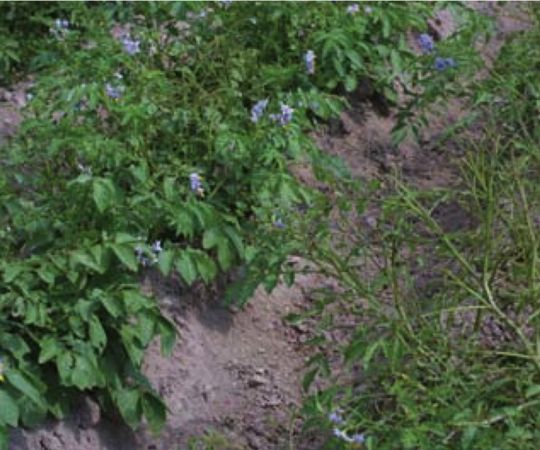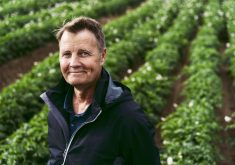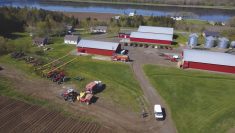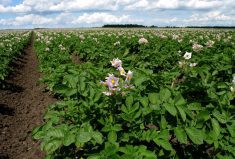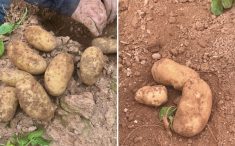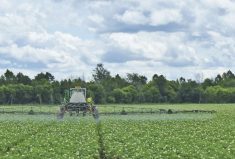When European explorers to South America first brought potatoes back to their home countries, it was a select few varieties they chose: those that could grow under longer day lengths. Most of the varieties at the Equator tuberize under short day lengths and can’t grow in the global North.
As a result, the potatoes we cultivate today are genetically narrow, according to Helen Tai, a research scientist at Agriculture and Agri-Food Canada’s Fredericton-based Potato Research Centre.
Read Also

Sensing the soil: Root cell research finds ‘stress hormone’
Research into how root cells react to soil stressors could help plants better adapt to changes in their climate.
But our North American potato varieties’ cousins in Peru, Chile and Bolivia have a wide variety of desirable traits, such as resistance to diseases and drought tolerance.
In the 1990s, Yvan Pelletier, an entomologist with AAFC, along with a group of potato researchers and breeders, imported a set of wild South American species kept at the United States Department of Agriculture’s potato germplasm bank at Sturgeon Bay, Wisconsin. Their goal was to begin a breeding project that would result in higher Colorado potato beetle resistance in local varieties.
“We looked at the database on wild Solanum species that have been tested for various traits, picked six or seven and brought the species in and looked at them in terms of their resistance to Colorado potato beetle in New Brunswick in the field,” says Pelletier, now retired. “We asked the breeders — ‘Can you work with them?’ The answer was ‘Yes, but it’s extremely difficult.’ So we looked again and brought in another six or seven species that would be easier to cross with Solanum tuberosum.”
Wild species are not easy to cross with cultivated varieties, partly because the potatoes grown commercially here have four copies of the genome (tetraploid), while many wild species have two copies (diploid). “Some wild species will combine naturally with potato, some won’t,” says Helen Tai, a research scientist with AAFC. “The seed ball is the result of fertilization between two plants and the seeds are where you get the new genetic combinations. We call this an intercross, and the [resulting] plant is called an interspecific hybrid.”
Of the wild species, a few stood out to the researchers, including S. oplocense, a variety that could cross and make seeds with the S. tuberosum, and which also exhibited disease resistance.
- More Country Guide: Hard wired
Pelletier, as the entomologist on the team, was concerned mainly with S. oplocense’s degree of resistance to pests. “I was concerned with how resistant the plants were and why they were resistant. S. oplocense had effects on both the adults and the larvae,” he says.
Overcoming the problem of day lengths was the first step for Pelletier, and he worked with David De Koeyer, a geneticist at AAFC, to accomplish this by crossing S. oplocense with varieties adapted to long day length conditions. “They took only a few crosses with S. oplocense to get there,” says Pelletier.
Once the day lengths issue was dealt with through breeding, researchers were able to focus on other qualities, such as size, colour, shape and eyes, in order to achieve marketable varieties.
According to Tai, this selective breeding is a complex process. “Once they combine the wild species through an interspecific cross and get progeny, the progeny is then backcrossed to different varieties of potato,” she says. “De Koeyer has done that in four generations just to get rid of the traits from S. oplocense that are undesirable.”
Positive traits
Once negative traits are removed, breeders can focus on which traits they wish to include in new germplasm.

Tai and De Koeyer, along with Benoit Bizimungu and Agnes Murphy, the potato breeders involved in the project through AAFC’s Potato Research Centre, are focused on working with S. oplocense and other varieties to incorporate a selection of traits that are desirable to Canada’s major players.
S. oplocense’s resistance to CPB makes it a highly promising prospect. According to Pelletier, the wild varieties of potato resist colonization by CPB adults and larvae through the release of chemical signals. Some of the varieties release this chemical as a gas, and the beetle reacts to the smell. In S. oplocense the beetle reacts to the taste of the plant, which while repellent to the beetle is non-toxic, according to Pelletier. “If the chemical is not toxic, it’s more difficult for the beetle to change their behavior. That gave us an indication of how long the resistance will last,” he says.
The wild species are remarkable for their extremely low feeding rates in the field, says Tai. Her work has involved conducting chemical analyses to study the mode of action by which the plants resist CPB. “We have discovered characteristics of the leaf that the beetle dislikes in the wild species, so now we are selecting plants that produce that chemical (a metabolite) as a way to ward off the beetle,” she explains. “We are also looking for the genes that control production of the chemical to develop a genetic marker.”
A goal for potato breeding is to introduce disease and pest resistance in new varieties while maintaining yields, agronomic and processing traits to industry standards.
“Breeders try to combine resistance traits at the same time as meeting the needs of the market, and to make that easier we’re developing a system of markers to select the traits,” says Tai. “The goal is to find a potato that can produce marketable yields under disease and pest pressure.”
Chip and fry processors have highly specific requirements for processing potatoes, which makes development of new varieties for these markets an even greater challenge. “All kinds of criteria have to be met first, so we’re in early stages with this germplasm,” says Tai.
While there are no offerings yet for S. oplocense, the team has crossed materials into table market potatoes, as the table market has fewer restrictions than processors in terms of dry matter, size and uniformity. The first introductions will be for the table market, with processing varieties hopefully following within the near future.
This article first appeared in the 2014 National Potato Guide


